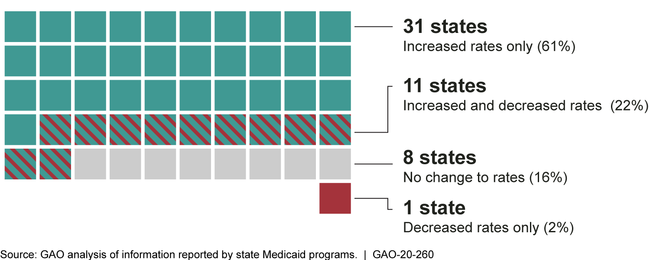Medicaid: States' Changes to Payment Rates for Substance Use Disorder Services
Fast Facts
Medicaid is the largest source of federal funding for services that treat drug and alcohol addictions. We looked at state Medicaid programs’ changes to what they pay for these services from 2014–2019.
Most state Medicaid programs increased payment rates for at least one addiction treatment service (e.g., counseling); rate decreases were less common.
Higher rate increases can encourage more addiction treatment service providers to accept Medicaid patients. However, other factors also affect service availability. For example, some providers don’t accept Medicaid patients because of the paperwork and audit requirements.

Pills spilling out of a prescription medication bottle
Highlights
What GAO Found
Most state Medicaid programs reported that they increased the rates paid to physicians and other health care providers for services that treat substance use disorders (SUD), such as medication or behavioral therapy. Specifically, over 80 percent of all states increased rates for at least one SUD service from 2014 to 2019. About two-thirds of states' rate increases were targeted specifically to SUD or SUD and other behavioral health services, while the remainder were part of changes to rates for a broader set of Medicaid services. Decreases to SUD rates were less common and tended to be part of broader rate changes.
State-Reported Changes to Medicaid Substance Use Disorder Payment Rates, 2014-2019

Notes: “States” includes the District of Columbia. Percentages do not add to 100 due to rounding.
All six of the states increasing Medicaid SUD payment rates that GAO selected for closer examination reported increases for outpatient SUD services; the states varied in the extent to which they had increases for additional types of SUD services as well as other characteristics, such as the number and size of the increases. For example, Virginia increased rates for four SUD services, with increases ranging from about $50 to $350 per service, while Arizona increased rates for over 50 of these services, with all increases under $15. Montana and New Jersey also had rate decreases for a few SUD services, with the decreases in Montana accounting for most of the SUD rate changes made.
State officials and SUD providers in the selected states with larger rate changes reported greater effects on SUD service availability compared to those in states with smaller changes. For example, state officials said that larger rate increases helped increase the number of SUD providers participating in Medicaid, but did not generally note SUD service availability effects for smaller rate increases. Providers in selected states identified certain factors, such as Medicaid program requirements, that could affect how much the availability of SUD services increased or decreased following rate changes. While sometimes acknowledging provider challenges dealing with these factors, state officials said that program requirements were important to ensure quality of care, among other responses.
The Department of Health and Human Services provided technical comments on a draft of this report, which GAO incorporated as appropriate.
Why GAO Did This Study
SUDs—when the recurrent use of alcohol or drugs causes significant impairments—are a growing problem in the United States, affecting nearly 20 million adults in 2018. Medicaid—a joint federal-state program that finances health care coverage for low-income and medically needy individuals—is the largest source of federal funding for the services that treat SUDs. However, Medicaid beneficiaries may face challenges accessing SUD care, in part, because low percentages of SUD providers choose to participate in the program in some states. Increasing Medicaid payment rates is one option that has been suggested for improving provider participation.
The SUPPORT for Patients and Communities Act included a provision that GAO examine how SUD services are reimbursed. This report describes (1) the extent to which states made changes to Medicaid payment rates for SUD services; (2) characteristics of rate changes selected states made; and (3) the effects of the rate changes in selected states on the availability of SUD services for Medicaid beneficiaries. GAO collected information from Medicaid programs in all 50 states and the District of Columbia about fee-for-service SUD payment rate changes from 2014 to 2019. In six states—Arizona, Montana, New Jersey, Vermont, Virginia, and Wisconsin—GAO reviewed documentation related to these rate changes and conducted interviews with state Medicaid officials and SUD providers. GAO selected states that had rate increases targeted to SUD or behavioral health services, and that varied across factors such as also having SUD rate decreases, SUD providers' participation in Medicaid, and geographic location.
For more information, contact Jessica Farb at (202) 512-7114 or farbj@gao.gov.
